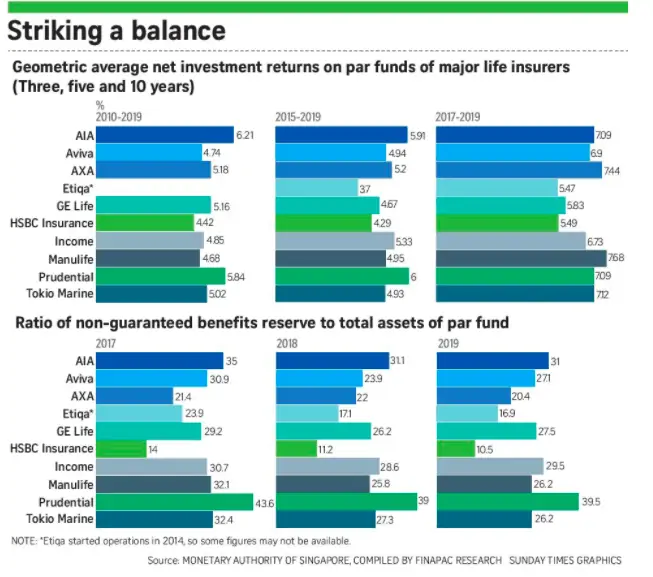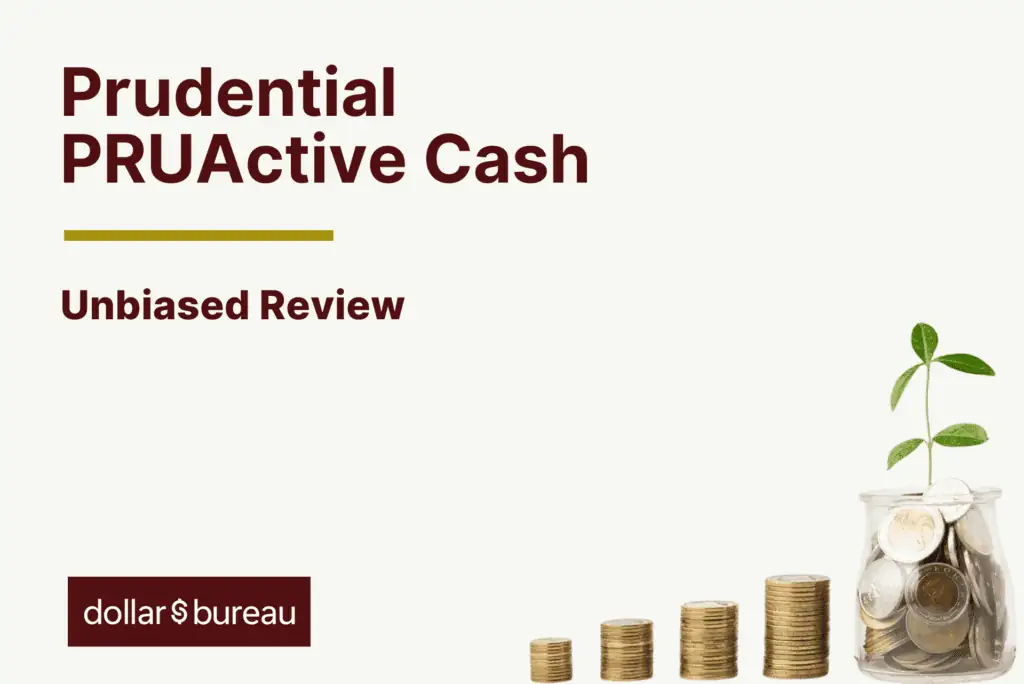Prudential’s PRUActive Cash is an endowment insurance plan that helps you save money while providing some form of protection.
With different individuals having different needs and preferences, the PRUActive Cash allows you to pick how long you want to pay for premiums and how long the coverage lasts.
Here is a comprehensive review of PRUActive Cash.
Read on.
My Review of Prudential’s PRUActive Cash
The PRUActive Cash is a pretty decent endowment plan that helps you save for your future.
While it does carry an aspect of protection, the PRUActive Cash only protects you in the event of your passing by providing your loved ones with a payout to help them cope with any financial obstacles they may face.
You also have the option to increase your coverage through the selection of riders available.
However, this is unlike other insurance policies, which can provide you with more coverage against other situations such as Critical Illness, Terminal Illness, or Total and Permanent Disability (TPD) as part of their basic policy.
While this makes the PRUActive Cash unsuitable for those seeking wider coverage and increased protection, this policy remains an ideal choice for those seeking to grow their funds relatively safely.
One of the significant advantages is the Yearly Cash Benefit, which allows you to receive a guaranteed yearly payment.
By supplementing your income, this money can be used to fulfil your immediate needs or any short-term goals you have.
In addition, with your preferred policy term, you will also receive a lump sum benefit when the policy comes to an end, supporting your long-term goals, such as buying a house, funding your children’s education, or enjoying a comfortable retirement.
Compared to other similar wealth accumulation products by Prudential, such as the PRUWealth Income or the PRUWealth Plus, the PRUActive Cash appears to be a compilation of each plan’s benefits.
By providing you with the monthly cash benefit of the PRUWealth Income and the flexibility of having regular premium payments like the PRUWealth Plus, it is safe to say that the PRUActive Cash is a policy that will definitely catch the eye of many prospective investors.
However, I have to say that the 3% in monthly cash benefit is lacklustre, so you should opt for an annuity plan if you’re looking for retirement income.
We’re also not big fans of endowment plans due to them requiring us to lock our money up for long periods (15 years minimally in this case), and the low returns we’ll get from it.
Because of this, we recommend checking out investment-focused ILPs instead if you’re keen to grow your money.
Regardless, we understand there’s a demand for endowment plans if you’re seeking something low-risk, thus, check out our post on the best endowment plans in Singapore, and consider talking to an unbiased financial advisor for a second opinion on whether the PRUActive Cash is for you.
This is because you’re about to lock in your money for a minimum of 15 to 25 years with Prudential’s PRUActive Cash, and the last thing you want is to find out that there are policies that might suit your needs better.
That’s why we frequently recommend our readers to spend extra time researching their available alternatives and to even get a second opinion as to whether the PRUActive Cash is the best for them.
If a second opinion is what you need, we partner with MAS-licensed financial advisors who have helped hundreds of our readers with policies that have been recommended to them.
And if this is something you might be interested in, they’re happy to assist you too!
Click here for a free non-obligatory second opinion.
Criteria
- Premium Term: 5 to 25 years
- Policy Term: 15 to 25 years
- No medical underwriting required
General Features
Premium Payment Terms
With flexibility in mind, PRUActive Cash offers a variety of premium payment terms that can be customised to match your unique requirements.
This allows you to select a single premium payment or opt for a regular premium payment term anywhere between 5 to 25 years with 5-year intervals.
In addition, those who choose to go with regular premium payments can also make their payment every 1, 3, 6, or 12 months.
Despite being an insurance policy, note that the PRUActive Cash is not Medisave-approved.
Hence you may not use your Medisave funds to support the premium payments for this policy.
Policy Terms
Like the premium payment terms, PRUActive Cash grants you freedom in this field to choose your preferred policy term, allowing you to customise your plan to have a policy term between 15 years and 25 years.
Protection
Death Benefit
Since the PRUActive Cash is a policy that mainly focuses on its goals as an endowment plan, it only provides you with basic coverage in the form of the Death Benefit.
In the event that the insured passes away, your beneficiaries will be eligible to receive a payout amounting to the higher of the 2 options below, less any amounts owed by the insured to Prudential:
- 105% of the total premiums paid up so far, excluding any premiums for additional benefits and any surrendered bonuses; or
- 101% of the surrender value.
Any remaining cash benefits with interest will also be included in the payout for either of the above options.
However, any overpaid cash benefits resulting from a delayed notification of the insured’s passing will be deducted from the Death Benefit payout.
Once the Death Benefit is successfully claimed, the policy will terminate.
Optional Add-on Riders
Crisis Waiver III
With the Crisis Waiver III rider, Prudential will waive your premiums in the event that you are diagnosed with any of the 35 specified Critical Illnesses (CI) that fall on their list.
Doing so ensures that you can get some form of financial relief, allowing you to focus on your recovery.
Early Stage Crisis Waiver
Unlike the Crisis Waiver III rider, the Early Stage Crisis Waiver targets medical conditions that are in the early stages, allowing you to waive your premiums for 5 years.
Do note that you are able to claim the Early Stage Crisis Waiver up to 2 times in the unfortunate event that you are diagnosed with an early-stage critical illness more than once.
For those facing intermediate-stage conditions, this add-on will also offer a waiver of premiums for 10 years.
Payer Security Plus
Apart from protecting yourself, you can also secure your loved ones with the Payer Security Plus rider.
This rider protects your family by waiving premiums on your spouse’s or child’s policy if something happens to you, whether it’s death, TPD, or CI.
However, those considering signing up for this rider should note that this rider’s coverage only lasts until the end of the premium term or until you reach 85 years old, whichever comes first.
Key Features
Yearly Cash Benefit
As part of the returns on your premiums, the PRUActive Cash includes a Yearly Cash Benefit for you to enjoy some form of financial liquidity even before your policy matures.
This benefit is a guaranteed yearly payment, starting from the 2nd policy year until the policy ends.
Under this benefit, the annual amount receivable will be 3% of your policy’s Face Value.
For those who are curious about what your policy’s Face Value is, it is not the amount of sum assured under your policy.
Rather, it is the total value of your policy at that point in time.
Policyholders of the PRUActive Cash have 2 options under this benefit:
| Your Choice | Prudential’s Action |
| Receive the Yearly Cash Benefit as regular annual payments | Prudential will pay the Yearly Cash Benefit on your policy anniversary |
| Leave the Yearly Cash Benefit to accumulate in value anytime during the policy term | Prudential will apply a non-guaranteed annual interest rate to the accumulated amount, accrued on a daily basis
↓ On each policy anniversary, interest will be credited based on the accumulated Yearly Cash Benefit and the previous year’s interest ↓ Accumulated amount will be used to pay for any payments due and any loans or interest owed to Prudential |
For those who have chosen to accumulate the Yearly Cash Benefit, you can also withdraw a minimum of $1,000 at any time.
If the balance accumulated is less than $1,000, you would have no choice but to withdraw the entire amount.
Maturity Benefit
Depending on your chosen policy term, the maturity date and time to maturity would differ.
Once your PRUActive Cash reaches maturity, you will receive this benefit as a lump sum. This lump sum would comprise the following components: less amounts owed to Prudential:
- Maturity Benefit, which can vary between 41.23% and 108.31% of your policy’s Face Value;
- Any non-guaranteed bonuses added to the policy;
- Final instalment of the Yearly Cash Benefit; and
- Any cash benefit left with Prudential.
Surrender Benefit
Apart from making a claim or waiting for the policy to mature, you also have the option to surrender your PRUActive Cash before it reaches maturity.
Upon doing so, you become eligible to receive the surrender value of your policy under the Surrender Benefit.
However, you would have to wait until after you have paid premiums for 36 months for your policy to have a surrender value.
The amount consists of:
| Component of Surrender Value | What it is |
| Guaranteed Surrender Value | The minimum amount that the insurance company guarantees to pay you if you surrender the policy after a certain period.
The exact value depends on the premium payment term of your policy. |
| Non-guaranteed Surrender Value | A non-guaranteed value based on the performance of the policy and the investment funds.
However, this part is not guaranteed, and the amount can vary. |
However, do note that any life insurance policy like the PRUActive Cash is a long-term commitment.
Surrendering the policy would equal an early termination of the policy, and early termination costs would apply.
Depending on your surrender value, the final amount receivable by you may be zero or even less than the total premiums paid, meaning that you would have suffered a loss!
Check your policy documents or talk to your financial advisor to determine how much you’ll receive upon early surrender.
Policy Loan
Under the PRUActive Cash, Prudential allows you to take a policy loan that advances your policy’s cash value.
Think of it as borrowing from yourself!
Hence, your life insurance policy will be treated as a form of security for Prudential, but you will need to repay it with interest (that goes to the insurer instead of your own policy).
Automatic Premium Loan
If you are unable or forget to pay your premiums within 30 days from its payment due date, Prudential will automatically lend you money as an Automatic Premium Loan to cover your premiums.
By doing so, this ensures that your policy remains active and you do not lose the coverage.
However, the loan amount is taken from your policy’s surrender value, and repayment will be required.
As a result, if the total amount owed to Prudential under your PRUActive Cash exceeds the surrender value, your policy will be deemed terminated.
Another thing to note is that the Automatic Premium Loan is not available to those with a single premium policy.
Surgical & Nursing Loan
Under the Surgical & Nursing Loan, you can apply for an interest-free advance to support your surgical or post-operation nursing expenses.
For those who plan on taking out this loan, do note that the amount of advance is restricted to the minimum of the following:
- Total premiums paid;
- 10% of the basic sum assured;
- 90% of the surrender value; or
- The surgical and post-operation nursing bills.
Do note that this loan cannot apply to bills paid by MediSave, MediShield, MediSave Integrated Medical Plan, or any 3rd party medical insurance plans.
This specialised type of loan helps cover the expenses associated with surgical procedures and nursing care offered in partnership with healthcare providers.
Bonuses
Considering the benefits provided by this plan, it is notable that both guaranteed and non-guaranteed benefits are included.
For the guaranteed benefits, you can rest assured that they will be paid regardless of the participating fund’s performance.
Where the participating fund’s performance becomes important would then be the non-guaranteed bonuses.
Under the PRUActive Cash, non-guaranteed benefits comprise of Reversionary, Performance, and Maturity Bonuses.
Despite being a non-guaranteed benefit, some bonuses can also become guaranteed once they have been declared, while some remain as non-guaranteed bonuses.
Although subject to variability, these non-guaranteed benefits offer added value and potential for greater returns in accordance with the future performance of the participating fund.
Reversionary Bonus
The Reversionary Bonus is an annual bonus that is added to your policy benefits after you have made 2 years’ worth of premium payments.
Based on an illustrated Investment Rate of Return (IRR) of 4.25% p.a., the Reversionary Bonus has a projected rate of $8.50 per $1,000 Face Value and $19 per $1,000 on accumulated Reversionary Bonuses.
Maturity Bonus
The Maturity Bonus is a one-off bonus that is paid out when your policy matures as a percentage of the accumulated Reversionary Bonus.
At an illustrated IRR of 4.25% p.a., the Maturity Bonus can be projected to be 45% to 147% of the accumulated Reversionary Bonus.
Performance Bonus
Like the Maturity Bonus, the Performance Bonus is also a one-off bonus which is a percentage of the accumulated Reversionary Bonus.
However, it is paid instead when the policy is surrendered or matured, and the amount depends on the policy termination date.
At an illustrated IRR of 4.25% p.a., the illustrated performance bonus rates for PRUActive Cash are as follows:
| No. of Completed Years in Force | Performance Bonus as a Percentage of Accumulated Reversionary Bonus |
| 1 | 0.0% |
| 2 | 0.0% |
| 3 | 5.0% |
| 4 | 5.0% |
| 5 | 10.0% |
| 6 | 15.0% |
| 7 | 20.0% |
| 8 | 25.0% |
| 9 | 26.0% to 30.0% |
| 10 | 26.0% to 35.0% |
| 11 | 27.0% to 40.0% |
| 12 | 27.0% to 45.0% |
| 13 | 28.0% to 50.0% |
| 14 | 28.0% to 75.0% |
| 15 | 28.0% to 95.0% |
| 16 | 28.0% to 94.0% |
| 17 | 28.0% to 93.0% |
| 18 | 29.0% to 92.0% |
| 19 | 29.0% to 91.0% |
| 20 | 29.0% to 90.0% |
| 21 | 29.0% to 89.0% |
| 22 | 30.0% to 88.0% |
| 23 | 30.0% to 87.0% |
| 24 | 30.0% to 85.0% |
| 25 | 30.0% to 84.0% |
PRUActive Cash Fund Performance
Asset Management
As the PRUActive Cash is a participating endowment plan, premiums collected from policyholders are used to buy sub-fund units.
This allows Prudential to generate returns and bonuses, which can be given to you, growing the pool’s value over time.
With that, it is key for anyone considering a participating insurance plan to always understand how the fund is performing, starting from the key indicators below.
Investment Mix
For those who are wondering how your premiums are allocated across various investment assets, Prudential has provided the asset allocations as of 31st December 2022.
| Asset Type | Strategic Allocation | Actual Allocation |
| Bonds | 47.5% | 58.4% |
| Equities | 29.5% | 25.8% |
| Property | 10.0% | 8.9% |
| Other Assets
(Such as Policy Loans, Cash, and Alternative Assets) |
13.0% | 6.9% |
| Total | 100% | 100% |
Investment Rate of Return (IRR)
By participating in asset investment, you have the potential to earn higher returns than traditional savings accounts.
However, it’s important to note that investments come with inherent risks (meaning that you could earn more or you could lose more), and the policy’s value can fluctuate based on the performance of the assets.
The following table shows the net past return rate of the participating fund, less any investment expenses.
| 2019 | 2020 | 2021 | Average of Last | |||
| 3 Years | 5 Years | 10 Years | ||||
| Investment Returns | 5.65% | 5.13% | -13.42% | -1.30% | 1.11% | 3.52% |
Accurate as of 31 December 2021.
From the numbers above, it is evident that Prudential’s participating fund has not been performing up to expectations in recent years, with a negative return in 2021 and as its average over the last 3 years.
However, this can also be attributed to the market downturn due to the COVID-19 pandemic, and potential investors can keep an eye out on this fund to see if there is any route to recovery in the coming years.
Industry Comparison
Despite the statistics on the fund’s IRR, the geometric net investment returns over the past 3, 5, and 10 years show that Prudential is consistently performing above the other companies, with almost the highest returns in all scenarios.

While the data is dated (2010 to 2019) and does not reflect future performance, this further supports the notion to pay attention to Prudential’s participating fund over the coming years and that we should not judge the fund’s poor performance too strongly over the past few years.
Total Expense Ratio
For those who may not know the Total Expense Ratio (TER), it is a ratio of a fund’s expenses compared to the amount of assets under the fund.
The lower the TER, the more premiums (invested by you) are effectively being invested for returns by Prudential.
If the fund’s actual expenses end up being much higher or lower than expected, it can affect the non-guaranteed benefits you are entitled to from the fund.
To give you an idea of how this fund has been managing its expenses in the past, you can look at the table below, which shows the TER for previous years.
| 2019 | 2020 | 2021 | Average of Last | |||
| 3 Years | 5 Years | 10 Years | ||||
| Total Expense Ratio | 2.50% | 2.67% | 2.65% | 2.61% | 2.71% | 2.83% |
Accurate as of 31 December 2021.
From the date, we can see that the fund’s average TER has been falling from the 10-year average, all the way to the 3-year average.
This indicates that the fund has been managing its costs better over recent years, translating to better returns for you.
It’s also important to compare the Average Expense Ratio of different insurers within the same industry to make informed investment decisions.
Here’s the table you can use to compare the expense ratios with those of other insurers between 2017 and 2019.
| Average Expense Ratio | 2017 (%) | 2018 (%) | 2019 (%) |
| AIA | 1.60 | 1.70 | 1.70 |
| Aviva | 2.54 | 2.58 | 2.80 |
| AXA Life | 8.45 | 5.55 | 4.84 |
| GE Life | 1.82 | 1.59 | 1.71 |
| Manulife | 4.98 | 4.88 | 4.74 |
| NTUC Income | 0.81 | 0.85 | 0.83 |
| Prudential | 2.99 | 2.95 | 2.92 |
| Tokio Marine Life | 1.35 | 1.33 | 1.06 |
| Average of the 8 Companies | 3.07 | 2.68 | 2.58 |
On average, Prudential did not perform the best during the years surveyed, performing only slightly above the industry average.
However, the improvement in their Average Expense Ratio from 2.99% in 2017 to 2.65% in 2022 also indicates their commitment to improving the fund over time.
Nonetheless, do also note that the data is dated (from 2017 to 2019) and does not reflect future performance.
PRUActive Cash Fees and Charges
All the fees and charges have already been factored into the premiums you’ll pay for the PRUActive Cash, meaning there will be no surprise charges or extra expenses to catch you off-guard.
Illustration of How PRUActive Cash Works
Willy is a 30-year-old newly married man who wants to secure his family’s future while enjoying some benefits along the way.
After deciding to go for PRUActive Cash, here is how his storyline played out.
Do note that the values below are worked out on the basis that the participating fund achieves an IRR of 4.25% p.a..
Policy Details
After choosing a premium term of 5 years and a policy term of 20 years, Willy is asked to pay $10,000 as an annual premium for the policy.
After the 5-year mark, he is done with paying premiums for his PRUActive Cash.
Events Occured
In the 2nd year of the policy, Willy is happily married, and that’s when he starts receiving a special yearly payment called the Yearly Cash Benefit.
The Yearly Cash Benefit that Willy gets based on his policy is $1,277, allowing him to support his new home and buy new furniture for his newborn daughter.
By the 3rd year, Willy decides to invest in himself. Using the Yearly Cash Benefit of $1,277, he enrols in coding courses to improve his skills.
From the 6th year onwards, Willy’s premium payments come to an end, and he is still eligible to receive the Yearly Cash Benefit payout of $1,277, which he uses to sign up for a new gym membership for himself and his wife.
Throughout the rest of the policy years, Willy continues receiving the Yearly Cash Benefit payout from Prudential instead of leaving it to accumulate.
This allows him to support various personal and family goals, such as sending his daughter to classes and supplementing his income to buy various items he wants.
Finally, when the policy reaches its 20th year, Willy receives the maturity benefit of $52,919 as a lump sum.
As he is now 50 years old, Willy decides to use this money to fund his daughter’s university education, setting her up for a bright future.
Summary of the PRUActive Cash
| Cash & Cash Withdrawal Benefits | |
| Cash Value | Available |
| Cash Withdrawals | Available |
| Health & Insurance Coverage | |
| Death | Available |
| TPD | N/A |
| Terminal Illness | N/A |
| Critical Illness | N/A |
| Early Critical Illness | N/A |
| Health & Insurance Coverage Multiplier | |
| Death | N/A |
| TPD | N/A |
| Terminal Illness | N/A |
| Critical Illness | N/A |
| Early Critical Illness | N/A |
| Additional Benefits | |
Optional Add-on Riders
|
Available |










